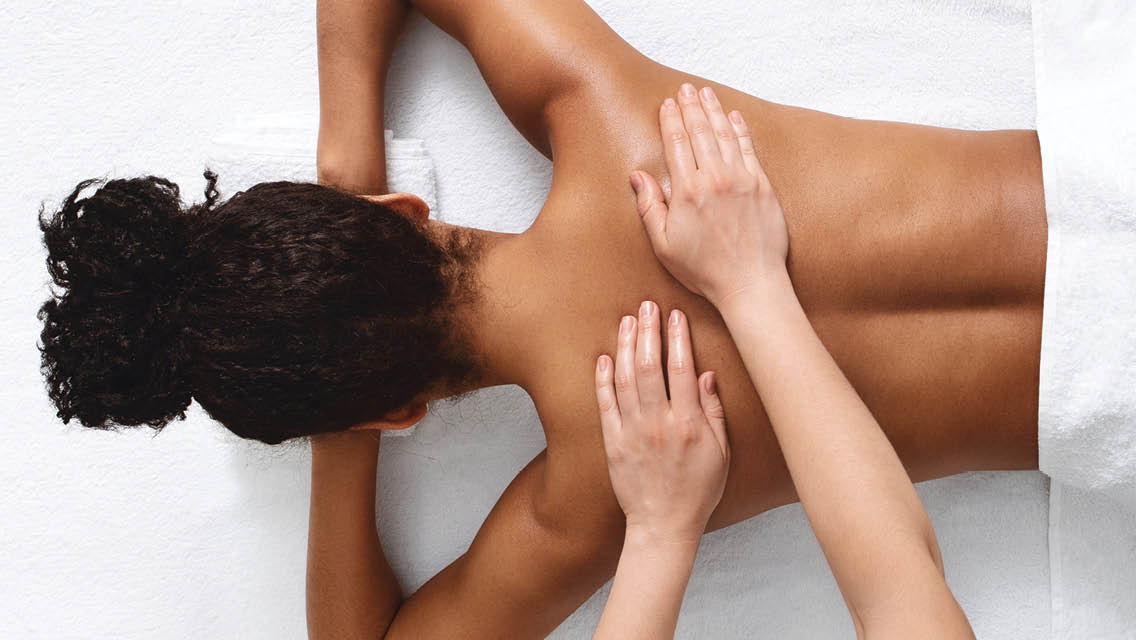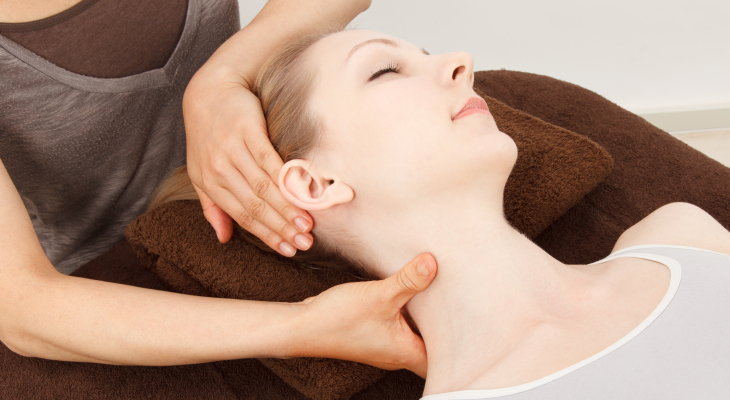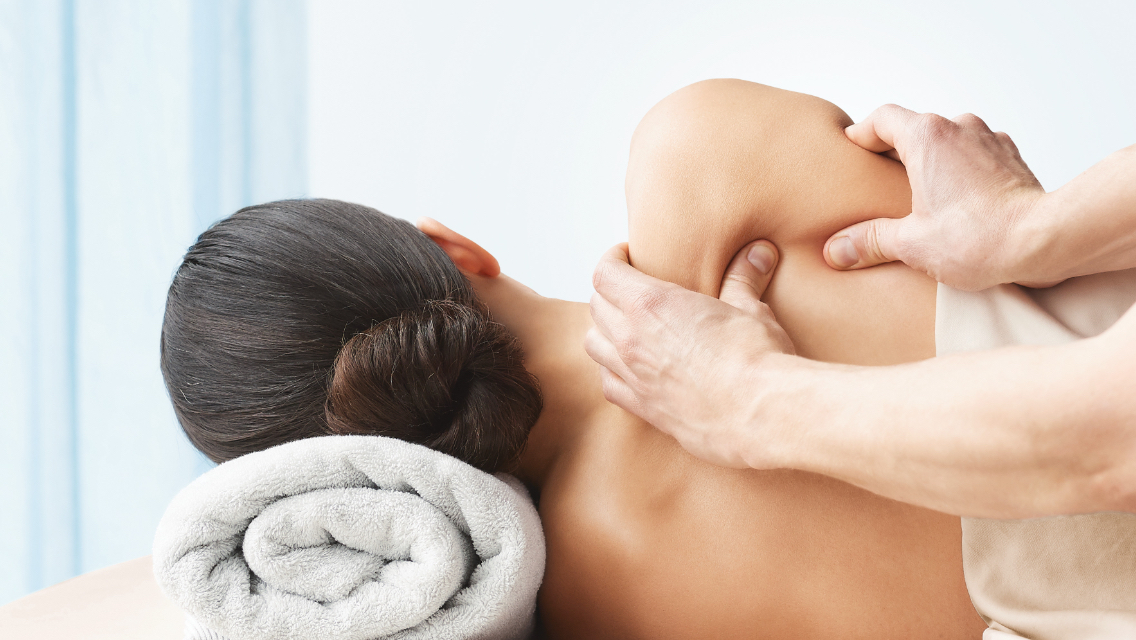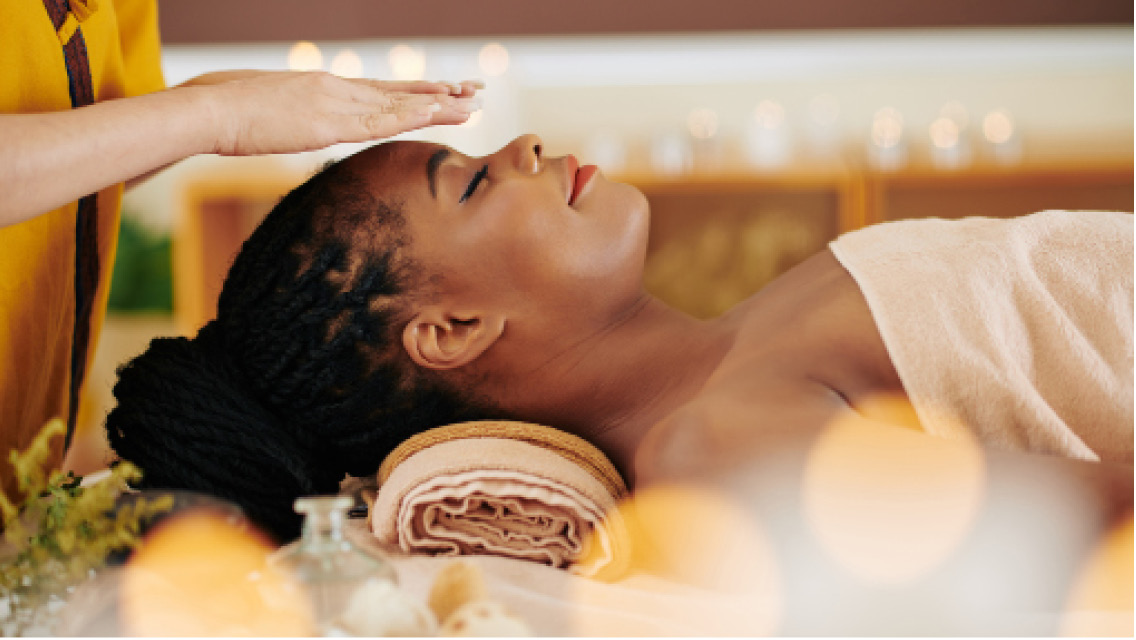Explore the following sections of interest:
Headaches | Pain | Lower Blood Pressure | Digestion | Anxiety and Depression | Immune System | Sleep
Knots untangled! Tension soothed! Soreness vanquished!
A professional massage can feel like a luxury. Yet a raft of research shows that it’s also a legitimate healthcare investment.
Massage can help reduce anxiety and depression, soothe pain, relieve headaches, improve sleep, support the immune system, lower blood pressure, and aid digestion. It also engages one of our most underappreciated senses — touch — which plays a key role in calming cardiovascular stress and helping us feel safe, bonded, and connected.
“Our nervous systems know touch,” says clinical psychologist and mindfulness teacher Christine Runyan, PhD. “They know closeness and a hug.”
Holding hands and embracing definitely help keep us healthy, but massage delivers even more benefits. “Massage is prolonged touch — a sustained stimulation of the body’s pressure receptors,” explains Tiffany Field, PhD, director of the Touch Research Institute at the University of Miami Miller School of Medicine.
It’s like oil for the Tin Man in The Wizard of Oz, says massage therapist Nell Rueckl, founder of Spot Spas in Minneapolis. “It affects every organ, muscle, and tissue within the body, including the brain. It helps the whole body function.”
“Often people don’t realize until they’re on the massage table that an area is hurting,” adds Nescelle Caberto, LMT, a massage therapist at LifeSpa in Overland Park, Kan. “Massage makes space for self-awareness and a connection between you and your body.”
Most of us became acutely aware of how much touch sustains us during the pandemic, when we could no longer embrace many of our loved ones, much less get a professional massage treatment. Now, some may be making up for lost time, seeking out the healing touch they’ve been missing.
Others may still feel hesitant, given how long our nervous systems have been associating closeness with danger. To address these concerns (and meet guidelines), most spas that offer massage have implemented new safety protocols, including extra sanitizing. You’re also likely to be alone in a room with a therapist, where both of you may be wearing masks.
If there was ever a time to get some hands-on support, that time is now. The pandemic’s effects on our bodies — from endless hunching over screens to countless hours of worry — are all ripe to be alleviated with healing touch.
Consider these seven good reasons to get back on the table.
1. Relieve Headaches
Massage can be particularly helpful for headaches and migraines related to muscle tension. Hormonal imbalances can also play a role in headaches, says licensed massage therapist Amy Daws; those imbalances may need to be addressed separately.
“But massage is a really important avenue to check out if you’re having migraines or headaches,” she says.
“People don’t realize that we have a layer of muscle that wraps around the whole skull,” says Caberto. “All my full-body massages include the scalp, because tightness there can radiate elsewhere. Everything in the body is connected.”
A small 2017 study in Neurological Sciences found that shiatsu-style massage may be more effective than pain killers at treating headaches. Shiatsu focuses on pressure points along energy pathways called meridians to restore balance in chi, or energy.
From this perspective, headaches are seen as an excess of chi concentrated in the head, neck, and shoulders. Releasing these local pressure points can help unlock stuck chi and provide relief.
Craniosacral therapy (CST) is another modality with a successful track record of relieving chronic headaches. CST uses a light touch to facilitate movement of fluids in and around the central nervous and craniosacral systems. Because this technique includes gentle attention to the skull and neck, it’s a go-to remedy for headaches.
“CST is good for manifesting better alignment,” says Rueckl. It helps align the hips, spine, and skull so nerve signals can flow unimpeded.
“If your hips are off balance, and you’re getting migraines, that could be a correlation. If I had migraines, I would definitely check in with a CST practitioner.”
A 2020 meta-analysis of 10 randomized controlled trials including 681 patients with neck and back pain, migraine, headaches, and fibromyalgia found that CST significantly eased pain and improved function for up to six months.
2. Soothe Pain
We often seek massage to relieve us of some pain, usually from muscle soreness. Yet it can also be used to address more complex chronic-pain conditions.
Some of massage’s capacity to reduce chronic pain stems from its effects on anxiety and depression. “Chronic pain is a marriage between the mind and body,” says Rueckl, noting that cortisol plays a role in both mood and pain perception. Because massage can lower cortisol levels and enhance dopamine, serotonin, and oxytocin, pain is reduced, along with stress and anxiety.
Massage also lowers the production of a neurotransmitter called substance P, which influences pain perception. Decreasing substance P levels appears to dampen sensations of pain.
One meta-analysis that reviewed studies of patients with fibromyalgia found that those who received massage therapy regularly for five weeks or longer saw immediate beneficial effects on their pain, anxiety, and depression.
Another study evaluated the effect of massage therapy on pain in an acute-care setting. Following a 30-minute massage, patients’ reported pain levels had fallen by more than half. Participants also noted improvements in emotional well-being, relaxation, and sleep.
Gate-control theory may also explain why massage alleviates pain: The nerve fibers that sense pain are shorter than those that sense pressure and temperature. Massage stimulates these larger, pressure-sensitive nerves, whose messages out-race the shorter nerves’ pain messages to the brain and then close the gate behind them.
Daws notes that trigger-point therapy and shiatsu are two forms of massage particularly well-suited to easing pain. Both release stuckness or areas of tension in the body and improve circulation.
3. Lower Blood Pressure
Want a nonpharmaceutical way to treat hypertension? Try massage. It stimulates pressure receptors in the skin called Pacinian corpuscles, which send signals to the vagus nerve — the largest of the body’s 12 cranial nerves. “Vagal stimulation slows the heart rate and lowers blood pressure,” explains Field.
One study separated 50 prehypertensive women into two groups. One group received 10 to 15 minutes of Swedish massage three times a week; the other simply relaxed in the same environment without receiving massage.
Blood-pressure measurements were significantly lower in the group that received massage, both immediately following the therapy and 72 hours later, suggesting that the benefits persist for at least a few days postmassage.
“By activating the parasympathetic nervous system through touch, the effects of chronic stress are decreased,” says Daws. “Your body can focus on conserving and storing resources for everyday processes such as digestion, elimination, and restful sleep.”
4. Aid Digestion
The vagus nerve is a key component of the gut–brain axis, which allows massage to support digestive health. “Massage is helpful for switching us to rest-and-digest mode, which allows the body to focus on those functions,” says Daws.
It can also support gut health more directly. Daws practices a form of abdominal massage that works on the fascia and other tissues surrounding the digestive organs. “You can literally help move stool through the intestine with abdominal massage.”
Releasing physical tension in the abdomen affects other areas of the body, too. “When a person is chronically constipated, the large intestine physically enlarges,” says Daws. “That can put pressure on the surrounding organs and the lower back, causing tension or pain. Abdominal massage that promotes regular elimination can reduce that pressure.”
5. Ease Anxiety and Depression
Peripheral nerves, including sensory nerves in our skin, relay information between the brain and the body. These nerves send signals to the autonomic nervous system, which regulates bodily functions such as heart rate, digestion, and breathing.
With chronic stress, the defensive sympathetic nervous system can get stuck in the “on” position, affecting overall health. “People in a constant state of fight, flight, or freeze can have more inflammation, pain, lower immune function, sleep problems, weight gain, anxiety, and depression,” explains Daws.
Stimulating the peripheral nerves with massage can switch the nervous system to the parasympathetic mode, which governs rest-and-digest functions. It lowers cortisol and increases oxytocin, a feel-good neurochemical that helps us feel connected and loved.
Massage can also instigate theta waves in the brain, which are associated with a state of deep relaxation verging on light sleep. “I know when I hear a client’s breathing change that they’re in that half-awake, half-asleep state,” Caberto says. “It’s a way to encourage being in your body and the present moment, versus thinking about the future or past.”
These results can have a positive effect on overall outlook. A 2020 study in Brain Sciences compared the effects of massage with those of a muscle-relaxation mindfulness exercise in 57 outpatients with depression. Researchers found that massage resulted in greater improvements, particularly with regard to tension, internal unrest, and hopelessness.
6. Support the Immune System
By reducing levels of the stress hormone cortisol, massage boosts the immune system, notes Field. “Cortisol knocks down natural killer cells, and massage knocks down cortisol.”
Field coauthored a notable study in the International Journal of Neuroscience that observed the effect of massage therapy on women with breast cancer. Compared with a control group, the massage-therapy group had higher levels of dopamine, natural killer cells, and lymphocytes by the end of the study.
Massage also helps facilitate circulation of lymph — fluid containing infection-fighting white blood cells — throughout the body.
7. Improve Sleep
Because massage is so effective at improving relaxation while relieving stress, pain, and tension, it’s not surprising that it can lead to better sleep. Massage increases serotonin, which is a precursor to melatonin, the primary hormone involved in sleep. It also helps to lower levels of potentially sleep-disturbing chemicals and increase relaxing theta waves.
Research has shown massage to be particularly helpful in relieving hormone-related insomnia, which often accompanies menopause. One study found that following eight weeks of twice-weekly massage, postmenopausal women with insomnia reported a significant decrease in depression and insomnia and an increase in their quality of life.
“For someone with insomnia, I’d start with massage and hydration,” says Rueckl. “And work to reduce screen time and increase time in nature — all the things that make you feel more human.”
Massage Modalities
Massage therapy takes many forms, and we may need different approaches at different times. “Sometimes a modality works for six months, and then you have to switch it up,” notes massage therapist Nell Rueckl. These are some popular forms of massage, and some of the conditions for which they’re best suited.
Active Release Techniques (ART) is a hands-on treatment approach designed to heal soft-tissue injuries and nerve damage, among other issues.
Acupressure uses the same approach as acupuncture, but with hands instead of needles. It applies focused pressure to points along the body to release energetic congestion and open the body’s energy pathways. Acupressure can be helpful for back pain, menstrual cramps, and headaches.
Chi Nei Tsang focuses on the abdomen, to clear out physical and energetic knots and tangles so that chi (energy) can flow smoothly. Good for digestive troubles and lower-back pain.
Craniosacral Therapy is a gentle, noninvasive approach during which a therapist applies pressure no greater than the weight of a nickel to the cranial bones, spinal column, and sacrum to balance energy, treat headaches, and reduce mental stress. Mild enough for infants, as well as the elderly.
Deep-Tissue Massage relies on slower strokes and targeted pressure, often with fingers, thumbs, or elbow. Great for releasing tension, reducing stiffness, and lowering blood pressure.
Hot-Stone Massage features smooth, warm stones placed on the body. These become focal points of relaxation as the heat penetrates and soothes tense muscles. Good for pain relief.
Myofascial Release is a light, sustained pressure applied to constrictions in the body’s fascia — the meshlike connective tissue beneath the skin and surrounding muscles and bones — to elicit elongation and release.
It’s good for reducing pain and improving range of motion. (To learn more about fascia’s many roles, see “The Fascia Connection“.)
Rolfing is a vigorous method of manipulating muscle and connective tissues to achieve structural balance. It can help relieve chronic stiffness, compression from injury or surgery, or pain from repetitive motion. Many find it particularly intense.
Shiatsu is a traditional Japanese modality, directing pressure to lines of energy (meridians) associated with health and well-being. It can ease chronic pain and tension, pain from an injury or accident, headaches, and sleep or digestive issues.
Swedish Massage involves a combination of long, gliding strokes, as well as techniques such as kneading and percussion. Swedish massage is thought to enhance health by increasing blood flow to the muscles.
Trigger-Point Therapy focuses on addressing trigger points that may appear as knots in the muscles — most often in the shoulders, upper back, and neck. This approach uses pressure to dissolve the knots, helping to relieve pain and symptoms surrounding the knots and in other parts of the body.
Energetic Touch
Many massage modalities incorporate concepts of subtle-energy manipulation. Shiatsu, for instance, emphasizes the movement of chi in the body along certain nodes and meridians, and Chi Nei Tsang aims to unravel stagnant energy in the abdomen.
Other healing practices, like Reiki, focus on facilitating the flow of energy but they use little touch, if any. “Reiki is focused on the energetic body,” explains licensed massage therapist Amy Daws. “It opens up areas that are locked down and need movement, but it works on an energetic plane instead of the physical.”
Reiki was developed in Japan in the late 1800s. Practitioners work with energy fields around the body to facilitate healing.
Proponents say it can be a valuable complementary therapy for a range of conditions, including pain, insomnia, and anxiety. And the lack of physical touch makes Reiki safe even for people in very fragile conditions, such as those with major injuries or in hospice care.
“If you’re having a trigger-point issue, Reiki probably won’t release it,” says Daws. “But energetic stuckness can turn into physical pain, and you can approach it from this other angle.”
We’re continuing to learn about the many positive effects of massage, but one that seems certain is that it offers us a chance to bring awareness, gratitude, and release to these bodies that do and hold so much for us every day.
“Massage promotes whole-body healing,” says Rueckl. “We don’t always check in with our bodies. Massage gives you a chance to say thank you.”
This article originally appeared as “Hands On” in the November 2021 issue of Experience Life.






This Post Has 2 Comments
I really enjoyed reading this article! It’s all so true… I now get massages at least once a week which really helps my headaches from tmj, stress, and herniated discs in my neck and back. It makes a huge difference!
This is a great, well written article. Massage therapy should be covered by all insurances!